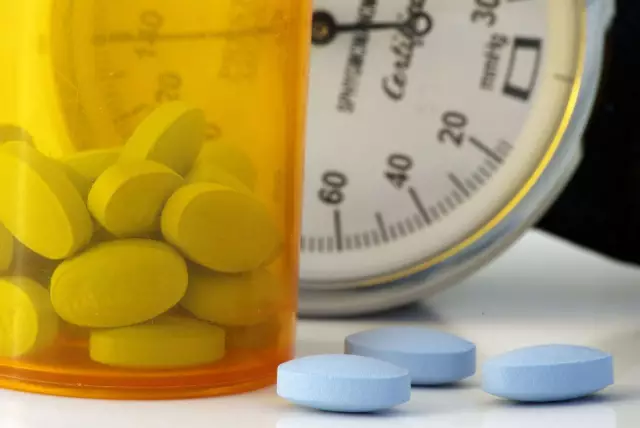- Author Rachel Wainwright [email protected].
- Public 2023-12-15 07:39.
- Last modified 2025-11-02 20:14.
Collapse

A life-threatening condition in which blood pressure drops and the blood supply to vital organs is impaired is called collapse. This condition is manifested by the appearance in a person of severe weakness and pallor, cooling of the limbs and sharpness of facial features.
Also, collapse means one of the forms of acute vascular insufficiency, in which there is a sharp drop in vascular tone or a rapid decrease in the volume of circulating blood, leading to:
- Suppression of vital body functions;
- Decreased venous flow to the heart;
- Drop in venous and blood pressure;
- Brain hypoxia.
It is important to correctly identify the cause of the condition and know how to provide first aid in the event of a collapse, as this can help save a person's life before being transported to a medical facility.
The reasons for the collapse
Possible causes of collapse can be acute infections, which include meningoencephalitis, typhoid and typhus, pneumonia, etc. Also, the condition occurs against the background of acute blood loss, with diseases of the nervous and endocrine systems, exogenous intoxications resulting from poisoning with organophosphorus compounds or carbon monoxide.
In medical practice, many cases have been recorded when collapse occurred during orthostatic redistribution of blood, resulting from an overdose of drugs such as antihypertensive drugs, ganglion blockers, insulin, etc.
Collapse can develop as a result of complications of the syndrome of small cardiac output, which occurs during acute myocardial infarction with tachycardia, deep bradycardia and dysfunction of the sinus node.
The collapse of the cardiovascular system can be due to:
- Puberty in girls;
- A sharp change in body position in a bed patient;
- High ambient temperature;
- Severe electric shock;
- Dehydration of the body;
- A strong dose of ionizing radiation.
The causes of collapse are also spinal and epidural anesthesia, acute diseases of the abdominal organs.
Signs of collapse
The patient suddenly develops a feeling of general weakness, chilliness, dizziness, chills, unquenchable thirst, body temperature decreases. Signs of collapse are manifestations such as:
- Sharpness of facial features;
- Cooling of the limbs;
- Pallor of the skin and mucous membranes (sometimes with a cyatonic shade);
- The whole body, or just the forehead and temples, is covered with cold sweat;
- Weakness of the pulse;
- Decrease in blood pressure.
When examining a patient, it is usually revealed that his heart is not dilated with deaf, sometimes arrhythmic, tones, rapid and shallow breathing, and decreased urine output. In the study of blood, it is revealed that its volume is reduced, hematocrit is increased, metabolic acidosis is decompensated.
The patient has a desire to lie down or sit with his head low, he does not feel suffocation despite shortness of breath, his consciousness is preserved or darkened, this state is characterized by complete indifference to what is happening around.
Signs of collapse are also a sluggish reaction of the pupils to light, convulsions and tremors in the fingers.
Types of collapse
In medicine, three types of collapse are conventionally distinguished:
- Hypovolemic;
- Cardiogenic;
- Vasodilatory.
The occurrence of hypovolemic collapse is due to dehydration of the body, severe blood loss or plasma loss, due to which the volume of blood in the vessels sharply decreases.
Cardiogenic collapse occurs against the background of:
- Heart failure;
- Acute violations of cardiac activity;
- A sharp decrease in cardiac output.
Vasolidation collapse is characteristic of severe infectious and toxic conditions, deep hypoxia, hyperthermia, hypocapnia, endocrinopathy, develops with improper use of drugs and with an excess of kinins, histamine and adenosine in the blood, leading to general peripheral vascular resistance.
Collapse: first aid and treatment
Depending on the cause of the condition, it is necessary to provide first aid to the patient in the event of a collapse in a short time. If the condition was bleeding - it is necessary to stop it, poisoning with toxic substances - to remove them from the body using specific antidotes.
Then the patient must be taken to a medical institution, where he will be prescribed an adequate treatment for the collapse - blood substitutes will be transfused using saline solutions, hemodez, polyglucin and rheopolyglucin, if necessary and strictly according to the purpose, blood components can be used.
Then, in the treatment of collapse, the patient is injected intravenously with 60-90 mg of Prednisolone, if the effect of its use is insufficient, add:
- 10% caffeine solution - 1-2 ml;
- 1% Mezaton solution - 1-2 ml;
- 0.2% norepinephrine solution - 1 ml;
- Cordiamine - 1-2 ml;
- 10% sulfocamphocaine solution - 2 ml.

With metabolic acidosis, the patient is injected intravenously with either 8.4% (50-100 ml) or 4.5% (100-200 ml) sodium bicarbonate solution. If the appearance of the collapse was caused by a syndrome of a small cardiac output caused by arrhythmia, antiarrhythmic drugs are usually prescribed, diluted 25, 100 or 200 mg of dopamine in isotonic sodium chloride solution or 5% glucose solution is intravenously injected, and also provide emergency cardiac stimulation.
Collapse is a condition in which there is a deterioration in the blood supply to internal organs and a drop in blood pressure, which threatens a person's life. When the condition develops, it is most important to determine what caused its appearance, since the subsequent treatment of the collapse should be aimed at eliminating the cause. Further, depending on the indications and the type of collapse, the doctor prescribes adequate drug treatment, can prescribe a transfusion of blood substitutes and apply pacing.
YouTube video related to the article:
The information is generalized and provided for informational purposes only. At the first sign of illness, see your doctor. Self-medication is hazardous to health!






